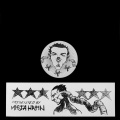| Hybrid Theory | |||||||
|---|---|---|---|---|---|---|---|
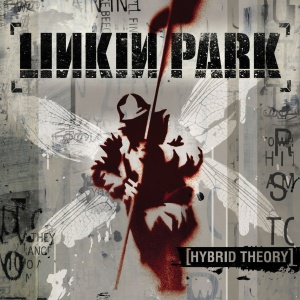 | |||||||
| Studio album by Linkin Park | |||||||
| Recorded: | March 7 - May 15, 2000[1] | ||||||
| Released: | October 24, 2000 (US) January 24, 2001 (Japan) January 30, 2001 (France) February 05, 2001 (Germany) | ||||||
| Length: | 37:51 | ||||||
| Producer: | Don Gilmore, Jeff Blue (exec.) | ||||||
| Label: | Warner Bros. | ||||||
| |||||||
Hybrid Theory is Linkin Park's debut album, released on October 24, 2000 through Warner Bros. Records. Four successful singles were spawned from Hybrid Theory: "One Step Closer", "Crawling", "Papercut", "In The End", but tracks such as "Points Of Authority", "Pushing Me Away", and "My December" were also sent to radio stations for airplay despite not being officially released as singles. The album only peaked at #2 on the Billboard 200, but it would go on to become the best selling debut album of the 21st century.
Background
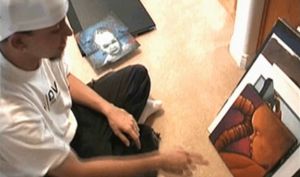
The band formed under the name "Xero" in 1996, the original lineup consisting of Mike Shinoda, Mark Wakefield, Brad Delson, Rob Bourdon, Joe Hahn, and Dave "Phoenix" Farrell. Vocalist Mark Wakefield left the band to pursue a different career as things weren't working out with Xero. Phoenix left the band around the same time to fulfill his commitment with Tasty Snax and was replaced by Kyle Christner. Chester Bennington joined the band in 1999, after auditioning via recommendation of his lawyers to Jeff Blue of the A&R Recordings branch of Zomba Music Group. They independently released the Hybrid Theory EP under the name Hybrid Theory in 1999. Some time after the EP was released, Kyle Christener was kicked out of the band.[2]
For three years, the band had been using their connections at Zomba to get the demos out to people who would listen to them[3] and were rejected by every major label and by a lot of independents as well, including by Clive Davis. The rise of other rap/rock fusion groups like Limp Bizkit, Kid Rock and Korn only made things worse for them. "For the first few years, the first couple of years trying to get a record deal, people were telling us pretty much that we weren't great and that we should change our approach and be more like some of the groups that were already popular. That was exactly what we didn't want to do, and we stuck to our guns. We wrote the record we wanted to write," said Brad.[4] After nine months playing forty two label showcases — including a showcase performance arranged by promoter and impresario Mike Galaxy at The Gig-Hollywood on Melrose Avenue — with no results, the band finally went to Warner Bros. Records as a developing artist[5] in November 1999[6] after a buzz started building up in the label industry and Jeff Blue took a position as vice president of their A&R (Artist and Repertory) department. "Several labels pursued me to do A&R after I secured a deal for Macy Gray, whom I developed at Zomba. I insisted that I bring Hybrid Theory under my new contract as my first signing. The one label executive who was truly interested in Hybrid Theory was Warner Bros.' Joe McEwen. Despite being the smallest offer, I knew the label provided the perfect environment for the band to thrive. However, before we started the album, McEwen moved on from Warner Bros., leaving the fate of the band uncertain."[7] Things almost fell apart in late February or early March 2000 when Warner CEO Russ Thyret (who liked the band) turned over many of his duties to Phil Quartararo starting February 28th, then Joe McEwen got demoted from A&R on March 8th and was replaced by David Kahne.[1] The more songs they made and re-recorded, the more interested in signing the band the label got.[8] Jeff made Hybrid Theory his first signing in April 2000.[9] Warner Bros. had passed on the band three times before that.[10]
Handling all its own management duties until that point, the band hired Rob McDermott at Andy Gould Management in February 2000[10] after previously being offered good deals with bad managers and bad deals with good managers.[11] McDermott recalls the moment they first met, "It was October 1999 when some scrawny rock kid with glasses and Jeff Blue met with me at a cafe on Sunset Blvd to discuss managing a new band Jeff was bringing with him to Warner Bros named Hybrid Theory."[12] They also signed with the booking agency Artist Group International in September 2000.[13]
The band decided that they wanted to make an impression with their new "teammates" at Warner Bros. Records and immediately put out a message to the entire staff saying they wanted to meet them. They set a date, and took over their conference room. They sat them down, exchanged pleasantries, and gave them some paperwork that outlined who the band were, what they intended to do, and how they thought their music, marketing, and fan club should be treated.
The band didn't realize how risky it was at the time, but luckily, label employees were enamored by their stunt, and decided to roll with them. The entire Warner staff was suddenly talking about the new band they just signed.[14] Despite this, the band would soon start facing many problems within the label.
The first problem was the name Hybrid Theory. Another band in the label was called Hybrid and was considered "the next big thing", so they didn't want Hybrid Theory getting confused with them. Each band member wrote different names on separate lists and met to decide which one they liked better. Some of the proposed names for the band were Clear (as in "Clear Plastic", but the label didn't like it), Probing Lagers, and Platinum Lotus Foundation.[15] Chester came up with "Lincoln Park" when driving and coming across a hometown park with that name.[16] Among 30 potential names, this was the only one all members of the band liked. Brad suggested that it would be important to acquire the domain lincolnpark.com, but it was already taken. It would take around $10.000 to acquire the domain, so they changed the new potential band name from "Lincoln" to "Linkin" in order to get it. linkinpark.com was registered on May 24, 2000,[17] and the park has since been renamed to Christine Emerson Reed Park.[18] The band also registered one domain name for each of the rejected names.
What the band didn't realize was that there was a Lincoln Park in virtually every major city in the country. Brad said, "There's actually a park in Santa Monica, where we live, called Lincoln Park, so we thought that was a cool name and started using it. We went on tour right after we changed the name, and we pretty quickly realized there was a Lincoln Park in every town. Kids would come up to us and go, 'Dude! You're from Lincoln Park too? What side?' The joke, basically, is that everywhere we go, people think we're local. So in that aspect, it's a really cool name."[19] Phoenix added, "There's been radio stations in Chicago that have said, 'Here's this local band, from Chicago, Linkin Park' — and that's actually been happening all over the country. In every major city you go there will be a Lincoln Park that's either a park, or a community... For a while, everybody thought we were local, like a support act."[20]
In the end, Mike said he was glad they changed their name. "It was a legal thing, but in retrospect, I think we’re glad we did. (rapidly) For one reason, because Hybrid Theory is a very descriptive name and it almost says, “This is what the band’s about”, whereas Linkin Park does not, and Linkin Park is the kind of name that does not define the band – other than the name defining the band."[21]
The next problem was their music. In the lyrics of Get Me Gone, which Mike describes as "a little glimpse into what goes on behind the scenes,"[22] Mike claims someone suggested they should just be a rock band and he should quit rapping. Chester was the first to receive the news through Don Gilmore. Chester was told he was "the star" and that Linkin Park should be his band. Mike would be relegated to just being the keyboard player or, worse, jettisoned. The band positioned themselves against it. Then the label wanted to bring in another rapper, a reggae vocalist called Matt Lyons. After that, they told Mike to try and rap like Fred Durst of Limp Bizkit. This led the band to cut off all communications with the label unless absolutely necessary.[23]
"At one point, one of the label reps came into the studio and was like 'I don't know, man. This doesn't sound right. This song was weird. This song doesn't sound right.' So our producer was like 'Hold on. Let me try something real quick.' He reaches over and turns a nob. Dude's like 'I don't know whatever you did, man. That's fucking perfect like this. So cool.' All he did was turn the volume up," said Chester.[24]
The band's image was also questioned by the label. When Mike submitted the original logo for Hybrid Theory to the record label, it was shot down by an A&R for appearing "too Asian."[25] Someone brought an image consultant who suggested the band should have a gimmick, saying Joe should wear a lab coat and a cowboy hat and call himself "The Doctor".[26]
Although Phil Quartararo, who was president of Warner Bros. Records at that time, takes credit for personally directing and overseeing the signing, recording and marketing of the band,[27] Chester says the president of the company didn't like the band[28] and didn't want to release their album. "We had support from a couple people within the record company but the top guy at the time was not a fan. He made that very clear that he was not a fan, made it very clear that he couldn't care less about the record and that we were literally the last item on the priority list beyond, below even probably getting the toilets cleaned. So it was pretty clear."[29]
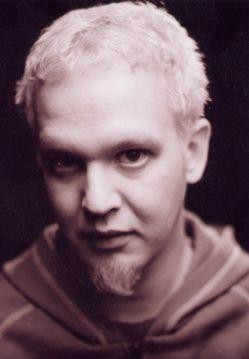
Ian Hornbeck, a musician from Seattle, was asked to play bass, but didn't join the band because of drug issues. His bass lines, however, were used on three songs on the album - "Papercut", "A Place For My Head", and "Forgotten". He said, "Yeah, man. That was me. It was ages ago. I just filled in to help them finish their album. Pretty awesome experience!"[30] Ian would hear himself on the radio for the first time at the age of 20 during his first visit to rehab. "That was a bit of a surreal experience; one that kicked off a sometimes seemingly endless stream of "what if's" over the years. What if I hadn’t had only four days to learn an entire albums worth of songs? What if I hadn’t chosen to stay up for several days on methamphetamines trying to learn them all, before popping enough Valium to neutralize a stampeding rhinoceros and hopping on a flight to Los Angeles to go meet the rest of the band for the very first time? What if they hadn’t decided to try and mend their relationship with their original bass player? What if they hadn’t seen me as being a talented, nice guy, but “too much of a liability?” What if I had taken things just a little bit more serious? Sure, I got the job done, but what if? More importantly, what if I screwed up my only chance at truly being able to pursue my passion in life: music? While they would go on to become one of the biggest bands in the world, I was left behind, contemplating the if's."[31]
Many other bassists auditioned for the band, namely Chester's friends Mace Beyers of Grey Daze and Jay Kereny of Lemon Krayola,[32] before Scott Koziol officially joined them as a fill-in member. Another candidate, Geoff Antonio, described the audition process. "They put an article out in the Recycler. I had just moved to LA from Virginia Beach. The ad said something like, Rock/Hip-Hop Band looking for Bassist. Signed to major Label, sound is between the Def Tones and the Black Eyed Peas. I was always a fan of rock and hip-hop. So I went and picked up the CD from Rob the drummer. He was living in Westwood at the time. From the moment I heard the CD I knew these guys were onto something. The production level was great. The sound was unique. I was particularly impressed with Mike Shinoda's skills as an MC. They were then called Hybrid Theory. I learned the songs, came in to play with them. They had a lock out in Hollywood right off of Hollywood Blvd. They asked if I was ready to play the songs and I said yes. Before we played they asked for me to play looking at the wall in front of us as if we were in a stadium. That's what I did, I played as if we were in the stadiums the would soon be rocking in the near future. Afterwards they had some interesting questions for me. They wanted to know the latest book I read. They also wanted to know if I graduated from college. Then they asked me if I drank and were waiting intently on my answer. I told them I did occasionally, but not when I play. They said that was good because they had an issue with the other guy and they could not risk all of what they had going on someone who wasn't sober. I told them if this is a sober band, that I would be sober as well and was actually happy to hear that they were focused. Afterwards we kept in touch for a while. Mike and Rob called a few times, they wanted to know what I was up to and I would ask what they were doing."[33] Mike Elizondo was also asked to play bass for the band at some point but chose to work with Dr. Dre and Eminem instead.[34]
Scott had only been in Los Angeles for about 6 months when he met them. He was referred to the band by Barry Squire who runs a LA musician referral service. Rob Bourdon gave Scott a call, they chatted for a bit then he sent Scott a CD of a few tracks to learn. He had a few auditions with the band before they started rehearsing in Hollywood six days a week for about eight hours a day in preparation for live performances and the recording of Hybrid Theory.[35] The only song Scott recorded bass for on the album was "One Step Closer".
Linkin Park worked throughout 1999 and early 2000 to complete work on Hybrid Theory. The album name is derived from the previous alias the band had. The name still matched the concept of the sound of the album, so they went with it. Brad said, "If you like The Roots you'll like Linkin Park, if you like Slipknot you'll like Linkin Park, and if you like Depeche Mode you'll probably like Linkin Park. That's one of the reasons we called our album 'Hybrid Theory', and that was the original band name. Was because we really approached songwritting from day one, which was really about almost four years ago, as a way to bring together different styles of music and really create a music that would be almost a new sound, that would be unique indentifiable as ourselves."[36]
Writing and Recording
After Chester joined Hybrid Theory in 1999, the group began writing new music immediately. They felt there was something special in their musical style, but it still needed work. "All of us, collectively, felt that this style of music could be blended a little bit better, not so jagged and kind of forced in there. We stopped practicing the songs and started working on new stuff," Chester said.[37] After releasing the Hybrid Theory EP, they continued work on their debut album, originally advertised as being due out in late summer 2000.[38]
Between February 2000 and June 2000, the band changed their name from Hybrid Theory to Linkin Park and recorded the album at NRG Studios in Los Angeles, California.
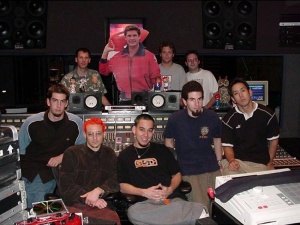
About the writing process, Mike said, "When we write, we write by recording, we don’t jam or anything, which means we have to record somewhere loudly. In the past, the place that we found was easiest to record in was my room. My walls are about three inches thick and my neighbours must have thought people were dying in my house! The whole neighbourhood could hear it!"[40] Chester jokingly said the band should be called Ten PM Stocker. "He thought of that name because I lived on a street called Stocker Street and, if we tried to record after 10pm, my neighbour would literally kick the wall connected to my bedroom. We were in the bedroom screaming our brains out and the guy next door and his wife were trying to sleep on the other side of the wall."[41] Each member would write their own parts and everyone would meet at one point or another to critique the songs and make changes from there.[42]
One big problem the band faced in recording Hybrid Theory was getting a producer. Jeff Blue, who acted as executive producer of the album, asked quite a few industry producers to work with Linkin Park, but had no luck. Finally, they were able to work out a deal with Don Gilmore, who helmed the project.[43] Chester said, "We met with a lot of people and had a very difficult time choosing a producer. But Don, aside from making things sound good, stood out as someone who could really push us to work harder as songwriters."[44] Mike said, "The thing about working with producers is that we initially just did it because it was what everyone else did as well. We don’t know why we did it; rather, we just did it because we knew that that’s how a record is made in our minds. I learnt a lot from Don Gilmore on our first two albums about how to record great guitars, drums and vocals. Basically learning the ins and outs about your basic pop or rock song, and he was really great at that."[45]
Speaking of how he first met the band, Don said, "I produced their first two records. This is going back a long time; we're talking like 1999 or something. The demos were brought to me through my manager and I thought it was good. I didn't necessarily think it was amazing, but I liked that they were trying to do something unique. So I met with them -- they were looking at some other producers -- and I went to a rehearsal, and Chester started singing and I was just like, "Oh my god, this is really special." I'd never really heard somebody sing that incredibly just in a little crappy rehearsal room. He wasn't really singing like that on the demos, and I just felt like, if he can sing like this in the studio, then we might have a chance of doing something."[46]
Don was quite intense with the band, being essentially a perfectionist with how the final songs should sound. The band has often talked about how many times he would make them rewrite the lyrics to songs and rework other instrumental parts. In an interview with Kerrang!, Chester talked about Don "hating all of their songs", "Well, actually he liked two – "Points Of Authority" and "With You". We basically had to write a new record in two months. We stayed at Mike’s house around the clock and wrote that album."[47] Don said, "There was all this talk about how it was a hard record to make, but as a producer, when I ask artists to do certain things -- like, "I think you can rewrite that and make it better," or "I think you can sing that better" -- and sometimes they don't come back with it written better or they don't go out and sing it better, then I'll try again a few more times, but sometimes you just never get there and you go with whatever. But with these guys, when I'd ask for these things and I'd push them to do better, they would. They would maybe get frustrated and angry, but the results were insane."[46]
When questioned if there was any hesitation to work with him at first (considering he had worked mainly with alternative acts), Mike said, "Obviously, we were going for a much heavier sound on our album, so it was a concern at the beginning. But it all turned out good in the end. Don was really good to work with." Regarding lyrical changes and restructuring of their older material, he said, "I am obviously happy with what’s on the album (or else we wouldn’t have committed it to tape!) but I do like the older versions as well. Most of the changes were done in order to make things a little more accessible. I wanted to make sure that people understood my lyrics. So I used metaphors that were a little more straightforward."[48]
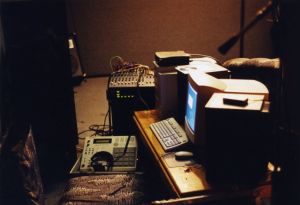
Mike would first work with Brad on the music before he and Chester would write lyrics.[47] "When we did Hybrid Theory and Meteora, Brad and I did the bulk of the writing. We would write the music and I would write the vocals and we'd give them to the rest of the band to make notes or change it, but essentially we were doing it like a hip-hop production team. This is the track, these are the vocals," said Shinoda.[50]
As for the lyrics, Mike said, "Chester and I started writing our best stuff when we talked about the parts and their meanings without defensiveness or pride. The importance is placed on the best part, not who is writing it."[51] Chester added, "I can't talk about this crappy thing that happened to me and expect him to be able to sing it. It has to be vague enough for both of us to go, 'We can relate to it.' And we found that by writing in that way, our lyrics were hitting home with a lot of different people and a lot of different age groups."[37] Mike further elaborated, "Personally, I have always been more interested in composition and songwriting, and honesty in my lyrics. I’m not so sure the latter is at the top of everyone’s priority list, in our genre at least. Our lyrics are more introverted than most. We probably focus more on an emotion, not the response. We’re not really an “I’m gonna kick your ass” type of band."[52] Jeff Blue commented, "Mike's lyrics had a dark vibe, his early demos all had rain, concrete, references etc. I loved Points of Authority, but the first demos are what kept me motivated. Mike is very prolific and cinematic, that grabbed me instantly as opposed to other artists at the time simply writing aggressive lyrics."[53] As for Don's influence on the lyrics, Chester said, "Our producer, Don Gilmore, made it a point to keep telling us, 'I want to be entertained, I don't wanna hear about your problems!' So, as much as it killed us, we tried to balance out the 'poor-me' parts with the entertainment."[54]
A fact that caught the attention of many people at that time was that Linkin Park was one of the few bands in their genre that didn't have swearing in their lyrics. Dave Farrell explained, "Really what it came down to for us is when Mike and Chester would sit down to write their lyrics, there was a challenge laid down to them both by the band and Don Gilmore, the producer of "Hybrid Theory," to express themselves to the utmost of their ability. Part of what came with that was when they had the feeling that they wanted to use an obscenity, there's always a better way than swearing to express yourself, if you have the time to sit down and think it through. It was almost a byproduct of that process. It wasn't even intentional that at the end of that process, there wasn't any swearing on the record."[55] Mike further elaborated, "It was scary in the beginning, when we started writing about what we felt. But once we realized we weren’t the only ones who felt that way, once we saw the audience was coming along with us on that, it freed us up. We wanted to be a little more descriptive, instead of just going ‘fuck’ all the time. We wanted to go into detail."[56]
Speaking about the sound of the album, Mike explained, "We love so many different types of music that it’s hard to differentiate where we’re getting our ideas from. We may write something and it doesn’t necessarily come from one genre. Sometimes it does and sometimes it comes from a bunch of different things. We have always wanted to do that within our band. When I first talked to the guys about starting the band it was always something like this. We wanted to do something that was a melting pot of these styles. I had said in an interview once that there was a theory of people in America being like a salad bowl or a melting pot. A melting pot is where they all come together and a salad bowl is where they hold their individuality and they exist together. At one point I thought our band was more of a salad bowl where each sound maintains its integrity and just exists in the song together but I totally have changed my mind. I think that it’s a melting pot where we’ve got a lot of things that come together but in the end they all just gel and just become one song and that’s what is most important to us. It’s just a song. It’s not the rap part and the rock part and the electronic part and the singing part and the rapping and the screaming and the whispering."[57] The band tried their best to make all those elements come together without feeling forced. "As part of the writing process, I record everyone directly into a computer to best integrate our digital and live elements. We spend countless hours mixing and matching parts until we get the right combinations and composition."
While promoting the album, the band have stated their influences were Black Star, The Roots, Mos Def, Roni Size, Aphex Twin, Depeche Mode,[58] Deftones, Sunny Day Real Estate, Nine Inch Nails, Dido,[59] Black Eyed Peas, Jurassic 5, Pharoahe Monch, Portishead, among others.
Later in his career, Mike explained how their engineer influenced the sound of the album. "There's so many different choices you can make when you're recording a record, and the farther along you are in your career, the more you know about all of your options. When we were making our first album, we basically left it up to our engineer to kind of help shape our drum sound. We said, 'Our drummer wants to play these drums,' and he was like, 'Cool, let's supplement those with these, and we'll A-B 'em, and see which ones you like.' But we didn't talk about how to mic them, we didn't talk about what room to use, we didn't talk about what gear the snare mics are gonna go through."[60]
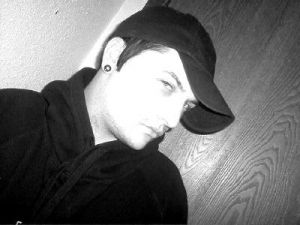
Personnel-wise, Dave was fulfilling his commitment with The Snax, which left Brad to play the majority of the bass tracks on the album. According to Scott Koziol, the band's touring bass player, the payout for Hybrid Theory says “Scott - 1 song, Ian - 3 songs, Brad - 6 songs.”[33] Mike explained, "Dave was gone and so we played his bass parts, me, Brad, our producer Don at one point was putting them in. We were just like... I didn't want Don playing bass on the record, it was our record. He's a good bass player but it's just the premise of it. We tried out of a couple of other people at the time. You mentioned Kyle Christener, he was in the band and we played with for a while. Scott Koziol was in the band for a while, we actually toured with Scott for a little bit. And there was another kid who played... he just like played on a couple of tracks but he wasn't a great fit."[61] Ian Hornbeck was asked to lend a helping hand by recording bass for "Papercut", "A Place For My Head" and "Forgotten". Scott Koziol recorded bass for "One Step Closer".
Dave did end up with songwriting credits for two of the twelve songs on the album, "A Place For My Head" and "Forgotten", and is credited as the band's bass player on later US pressings of the album (even though there's no photos of him in the booklet). On the versions where Dave is listed as a band member, Scott Koziol isn't credited for playing bass.
While still on The Snax with his high school friends, Dave and his bandmates gave each other ridiculous stage names. His was "The Phoenix", a name they got from the movie Mystery Men.[62] In the end, his was the only nickname that actually stuck, and was printed on the Hybrid Theory booklet. He says he's glad they decided on that name because the other option was "Little Bitch" from BASEketball.[63]
While looking for a producer, the band met the Dust Brothers who helped supply the sampled beats on "With You", which was the first collaboration by the band on an album song. The Visionaries rapper LMNO was introduced to the band by Kevin Sakoda and invited to be on the album as well but turned down the offer to focus on his solo album instead.[64][33] He later recorded an unreleased song with Mike.[65]
Don Gilmore asked the band for a chance to mix the album himself. After a week, he mixed 4 songs and delivered them on May 9. Jeff Blue didn't think it was good and booked Andy Wallace to mix the record instead. They initially were going to have Jeff, Mike and Brad meet with Andy in New York on May 18[1] until David Kahne, Jeff Blue's boss at Warner Bros. Records and one of the people who weren't 100% impressed with the band, offered himself to mix a few songs in order to improve them and convince the band to let him mix the rest of the album.[66] He promised that if they didn't like the mix they wouldn't be charged for studio time. Kahne mixed "Plaster" at Quad Studios in New York over the Memorial Day weekend and played it for Jeff on May 30.[1] Mike said that although his mix was good overall, the band had a feeling that Andy Wallace, who mixed Nirvana's Nevermind, would be a better fit for them and chose him to mix the album.[66] Kahne didn't keep his promise and charged $4000 for his mix. The band met with Andy Wallace in New York on June 18 and finished mixing the album on June 27. It took 3 attempts before they arrived at a version with which everybody was satisfied.[1]
Jeff Blue explained how the songs for the album were picked, "so we had dozens of songs, we narrowed them down to 14, and only 11 could make the album (plus Joe's cure for the itch) since contractually the band would only get paid on a certain amount of tracks. The band, Don, and I chose the songs we felt were strongest!"[53]
The album was mastered / sequenced by Brian Gardner on July 6. He noticed some songs had non-lyrical titles and suggested they'd change them. "Plaster" became "One Step Closer" on the same day and "Untitled" was changed to "In The End" a little later.[1]
A memorable moment for producer Don Gilmore was "When we finally played it for the record company... The record company had kind of just signed this band that they thought was a normal rap-rock group that would do okay. And when they first came in and listened to it, their jaws were on the floor, they couldn't believe it. They were bringing everybody from the record company over to listen to the album in the studio and there was so much excitement. And then it became a huge priority instantly for the label."[46]
Talking about the choice of which song gets a music video, Joe said "the record label decides".[67] As for the ideas for the videos, he said, "we have input but not up to us. not do we want to have the responsibility to choose. just write the best songs we can".[68]
The band's first goals included: making a 4-song demo, selling out the Whisky-A-Go-Go, and winning a Grammy.[69] With the release of Hybrid Theory, they would finally achieve the last one.
Linkin Park moved away from Jeff Blue after the success of the album, making Tom Whalley, who had known Rob McDermott (the band's manager) for years, their main contact at Warner. Regarding his relationship with the band, Jeff only said that it was "sensitive."[70]
Composition
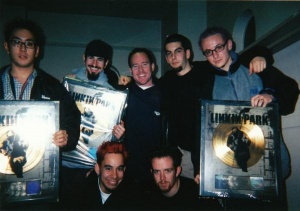
In early 2000, Linkin Park sent out quite a few demos to the record label to show their progress on songwriting. Several of these CDs have since leaked online in the decade or so following the album's release.
Some of the songs came together quickly while others took quite a long time. A risky move was to stick with most of the songs found on the demo CDs that Linkin Park sent out to record labels, which got them turned down from record deals. However, Don Gilmore's perfectionist attitude and the hard work of the band paid off, as the reworked versions turned out to be big hits. People who passed on the band would come to Jeff Blue and say the songs that made the album weren't in the demos he sent out to them, but all the songs were actually there. Even Warner Bros. Records made up a story about always believing in the band from day one.[18]
Before Hybrid Theory's release, Chester made a bet with Myra Simpson, national promotions manager at Warner Bros. Records. She had a triple-platinum Stone Temple Pilots plaque and said, "If you go gold by Christmas, I'll give it to you." The album was gold by Christmas 2000 and Chester got the Stone Temple Pilots plaque. He slept with it in his bunk on the tour bus every night.[10]
The original demos for "Forgotten" ("Rhinestone") and "A Place For My Head" ("Esaul", named after a friend of the band)[72] date back to when the band was called Xero and had Mark Wakefield on vocals. Because of this, he and Phoenix have songwriting credits on these songs. Both songs were on the audition tape the band sent to Chester in March 1999.[73][74]
The earliest known version of "Rhinestone" was released in 1997 on the Xero cassette tape, with programmed drums. After the band got a development deal from Zomba Music Group, they were able to buy new instruments and equipment to do better recordings.[11] It's unknown how many songs the band recorded after this, but a new version of "Rhinestone", still with Mark Wakefield, was featured in the 1998 series The Crow: Stairway To Heaven.[75] The episode with the song aired in May 1999. The earliest known version of "Rhinestone" with Chester Bennington on vocals came from a 9-track demo CD that dates from January 7, 2000 and already had different lyrics. The band can be seen rehearsing the song during Marc Ostrick's Lockout webseries which was recorded on February 24, 2000. According to Mike Shinoda, Brad Delson never got past the working title of the song and still calls it "Rhinestone".[76] In the LP Underground 12 booklet, Brad says the song is "definitely a fan favorite" and its spirit is "intimately interwoven into the formative identity of the band." Its original version was created by Brad, Joe, Mike and Mark.
"Stick N Move" was another track on the 1997 Xero tape and, like "Rhinestone", had programmed drums. A short instrumental version of the song, dating from 1998, was released on the LP Underground 9.0: Demos CD and is labeled as a "Runaway" demo.
Written by Mike Shinoda and Mark Wakefield, "Stick N Move" was played at all their early shows with their original singer and was always a popular song with the audience, so they brought it into the studio for Hybrid Theory; but producer Don Gilmore didn't like it.[77] The tempo and the main riff was then used in the creation of "Runaway". Because of this, Mark received songwriting credits for the song. Chester has said "Runaway" was the most difficult song to write/record because it "took literally like 6 years to write."[78] He has also said it's one of the worst songs they've written.[79]
Mike stated in 2003 that "A Place For My Head" was written "seven years ago" (1996).[80] As soon as Chester joined the band, the band re-recorded the song with him, still with the original lyrics. This version is available on the LP Underground Eleven CD and a rehearsal video of this same version can be found on the Frat Party At The Pankake Festival DVD as an easter egg. A completely reworked version of the song was included in the 2-track CD the band recorded in 1999 after the release of the Hybrid Theory EP. The band can be seen rehearsing this version during Marc Ostrick's Lockout. Curiously, by the time it was filmed (February 24), a version of the song with slightly different lyrics had already been recorded, found on a CD dating from January 7, 2000. Sometime around April 8, 2000, another version of the demo was released for free download on the band's website.[81]
Brad went to Ibanez and played on a lot of different guitars until he found one with a piezo pickup, a setting that allows an electric guitar to sound like acoustic guitar. The first song he thought of playing was "A Place For My Head" and he liked how it sounded. The guitar was borrowed to record the album version.[57]
Another Xero song named "Pictureboard" was written by Mike, Brad, Mark and Joe and re-recorded with Chester, but the band abandoned it. According to Mike, it contains a Barry White sample that prevented its release to the LPU in later years.[82][83] He confirmed it was never reworked into another song[84] and, describing the song, he said "it isn't even that good."[85] "Pictureboard" was on Chester's audition tape and Brad recalls it being the first song he heard Chester's voice on.[83]
A song named "Slip", for which Mark also received songwriting credits, was in the first batch of songs the band worked on with Chester. Various versions were recorded, but they never felt compelled to release it. The band can be seen rehearsing a version of this song during Marc Ostrick's Lockout. An earlier version was eventually released on the LP Underground Eleven CD.
There was another Xero song recorded with Chester and brought to Don Gilmore for Hybrid Theory but its title is unknown. Mike said the song was "terrible" and didn't make it past being a demo.[86] It's possible this song could be either "Dreamer" or "Weight".[87]
Other Xero demos written by Mark and Mike like "Deftest", "Dialate", "Fuse" and "Reading My Eyes" were likely never recorded with Chester. On "Deftest", Mike said they "were just testing out ideas" and "it sounds like shit";[88] "Dialate" contained a Wu-Tang Clan sample that had to be cleared for inclusion on the 20th anniversary edition of Hybrid Theory; Mike has said "Fuse" was one of his favorites back in the day, but "it stayed in a hard drive;"[89] and "Reading My Eyes" would only be played with Chester for the first time in 2006.[90][91][92]
A beat called "Emo" evolved into the song "She Couldn't" which was written in 1999 by Chester, Brad and Mike and discovered in a 8-track demo CD from February 2000, but the band had to abandon it.[93] Just like "Pictureboard", "She Couldn't" had samples which prevented its release. The song it sampled was "B-Boy Document '99" by High & Mighty.[94] According to Mike, this was one of the earliest demos created with Chester and exactly the type of song that would become part of Linkin Park's identity way down the line on albums like Minutes To Midnight and A Thousand Suns.[95][96]
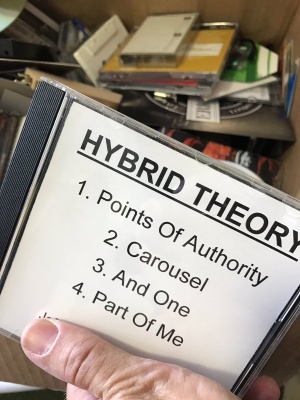
"And One" from the Hybrid Theory EP was the very first song the band wrote with Chester. After releasing the EP, they continued work on the track for inclusion on the debut album but it didn't make it to the final tracklist. While there's no different studio recording of the song (the version on the demo CDs are basically the same but with the audio channels switched), its live version featured a different arrangement than the one on the EP. According to Brad, they took the outro and made it the bridge and pulled the rhythm tighter.[98]
In the first batch of songs the band worked on with Chester, there was also a song called "Blue". The band didn't like the song, but they thought there was something special about the vocal at the end of it. Chester and Mike took the melody and wrote new words to it. Chester recorded the vocal track, Mike wrote the guitar under it, then they took it into the studio so everyone could work around it and it became "Crawling", a song that had its beat originated from another demo titled "Sky".
The earliest known demo of "Crawling" was featured on a demo CD dating from January 7, 2000. A second version of the song with new instrumental and vocal takes dates from February 2000. By April 25, 2000, the song had lost its rap bridge. Brad describes Chester's vocals on "Crawling" as an example of how he expanded their writing ability in the sense of vocal range.[4] However, Chester said "Crawling" has caused him "the most trouble live more than any other song."[73] The lyrics deal with Chester's struggle with drugs and alcohol[99] and is about taking responsibility for his actions, admitting having a problem with himself.[100] According to Mike Shinoda, the music on "Crawling" was heavily influenced by Depeche Mode.[101] The song was the second single released from the album and won a Grammy Award for Best Hard Rock Performance in 2002.
While trying to figure out ways to add a hip hop flavor to their music creation process, the band created "Hurry", a demo with guitars and drums recorded straight into Mike's MPC and played off of pads. As an attempt to play with a particular back-and-forth song structure, the demo evolved into "So Far Away", a song described by Brad as "a foreshadowing of Shinoda's melodic facility." Mike said the song was an experiment to figure out if he could sing, but it was eventually scrapped.[102] A version of "Hurry" was released as a downloadable track for the LP Underground 15 CD while "So Far Away" was released in the LP Underground 12 CD.
"Could Have Been" was another early song that didn't make the album. It was written by Chester, Brad and Mike and released in the Hybrid Theory (20th Anniversary Edition).
Two other songs from the Hybrid Theory EP, "Part Of Me" and "Carousel", were re-recorded for inclusion on the album. Reworked versions of the songs are featured on a demo CD dating from January 7, 2000. A third version of both songs dates from February 2000. Both tracks were written by Chester, Brad, Joe, Mike and Rob. The original demo of "Part Of Me", "Chair", was written around a sound that Brad collected of a car alarm. Mike sampled and looped it, Brad wrote the guitar, and they both worked on the song around it.[57] Regarding its lyrics, Mike said they are self-explanatory.[103]
"By Myself" originated from elements of a short instrumental piece called "Sad", which was released on the LP Underground 9.0: Demos CD and dates from 1999. According to Mike, Chester had never screamed in a song before and they had to loan him CDs to get tips on how to do it. He eventually found it "fun to let all that energy out" when screaming.[104] The song was created by Mike, Brad and Chester.
The first known version of "By Myself" can be found on the 2-track CD the band recorded in 1999 after the release of the Hybrid Theory EP. After the CD was released, the song name was changed to "Super Xero". A demo CD dating from January 7, 2000 featured a new version of the song, on which the band worked on until at least February 2000. A version of the song (now called "By Myself" again) released for free download on April 8, 2000 on the band's website was similar to the version on the 2-track CD but slightly different lyrics during the bridge. Another early version of "By Myself" was released on Warner Brothers Records' Raw Power sampler CD sometime before May 30, 2000. This version has the exact same lyrics as the one on the 2-track CD but features a different vocal take.
Like "By Myself", "Points Of Authority" was derived from a short instrumental, called "Oh No". The earliest known version of "Points Of Authority" is the one from the LP Underground 12 CD. In this version, the bridge from the album version is actually the chorus. A similar, but still different, second demo of the song dates from January 7, 2000. A third demo, closest to the album version, dates from April 25, 2000. This version already featured the final chorus, but the intro and bridge had alternate rap lyrics. It was released on the band's website for free download sometime around June 8, 2000.[105]
Mike said "Points Of Authority" was the most difficult song to write on the album. It didn't have a chorus for months and Don Gilmore was putting a lot of pressure on them to write more to it. Mike, Brad and Chester eventually finished it.[106] The original riff for "Points Of Authority" was created by Brad. When he went home, Mike decided to cut it up into different pieces and rearrange them on the computer. Brad had to learn his own part from the computer, but he wasn't bothered.[10] He has stated "Points Of Authority" is one of his favorite songs from Hybrid Theory. The song was intended to be the fifth and final single from the album, with a release set to January 7, 2002,[107] but was ultimately cancelled. Despite this, a music video was still released.
The original title for "In The End" was "Untitled", but the band decided to change it after D'Angelo released a single called "Untitled (How Does It Feel)" in early 2000.[76] The song was created by Mike in the band's rehearsal studio on Hollywood and Vine. He worked overnight in a room with no windows until the song took shape. Mike played the original seed, which included piano and the chorus, to Rob and he told Mike how much he wanted a song that was really true about some aspect of life and this was exactly what he had been thinking.[106] Chester however, wasn't so fond of the song. He thought it was a "pile of shit" and didn't want it on the album,[108] but since then, he has changed his mind, saying "In The End" is a good song that stands the test of time.[109] About the lyrics, Mike said, "I think I was reacting to the things we as a band had gone through in the beginning. The song almost doesn’t know if it wants to be optimistic or pessimistic – the beginning is a little dark, but you can’t tell (lyrically) if it resolves or not. That’s what I like about it."[51] The whole verse for "In The End" is harmonics which Brad came up on his clean guitar.[57] He and Mike worked together on the bassline and composition.
The earliest version of "In The End" is the one from the LP Underground Eleven CD. Right before the band went into the studio to record their debut album, the beat Mike had originally written for the verse was scrapped and Rob recorded a new one.[106] This new version can be found on a demo CD dating from January 7, 2000.
"In The End" was released as the fourth and final single from Hybrid Theory, with a music video inspired by the anime film Princess Mononoke.[110] The Hybrid Theory EP track "Step Up" was a b-side in the single.
The first known versions of "One Step Closer" ("Plaster"), "Papercut" and "With You" ("Dust Brothers") are found on a CD that dates from April 25, 2000.
"One Step Closer" came about after the band had spent about 2 weeks trying to write "Runaway". The band was taking out their frustrations at the inability to finish "Runaway" as well as the problems they were facing with the record label and the constant pressure from producer Don Gilmore. Mike said he and Chester were "just fed up with everything that was going on and we got to the end of our ropes and wrote the song."[111] The song was written in Mike's apartment. While the music came together quickly, the lyrics would take a few tries. The lyrics "I cannot take this anymore/I'm saying everything I've said before/ All these words make no sense," and the chorus, "Everything you say to me takes me one step closer to the edge." came from the band's frustration of handing Don lyrics and he grabbing them and telling Chester to do it again, without even looking.[47][112] Mike wrote "Shut Up" as a rough example for Chester to scream and they kept that lyric. After the song was done, the band thought for a minute that it wasn't a good idea to write that song and it sounded bad.[57] Chester in particular thought it was a "pile of shit" and didn't want it on the album.[113] Despite this, the song was released as the album's first single and Linkin Park's first single overall. Its title, "Plaster", was changed to "One Step Closer", which Mike said was a little bit more descriptive.[57] Scott Koziol recorded bass for the song and can be seen playing in the music video. The album version was mixed by Andy Wallace, but a version mixed by David Kahne exists and dates from June 2, 2000.
According to Mike, "Papercut" was a song that came together relatively quickly[51] and never lost its working title.[76] Describing the song, he said it has jungle and hip-hop elements.[114] Brad, Chester[115] and Mike all have mentioned "Papercut" as being their favorite song at some point because it "best integrates all our influences into one song and does it in a way that's tasteful and cohesive."[116] The song was released as the album's third single exclusively in the UK.
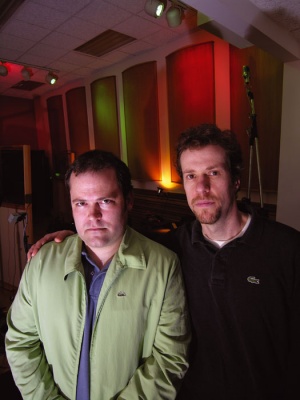
Linkin Park met the Dust Brothers while looking for someone to produce the album. After the meeting they decided to try writing a song together. The Dust Brothers came up with drum loops and different Moog and synth sounds and the band centered in on those Moog and synth sounds, coupling them with guitar and live drums.[116] During the same sessions,[117] they worked on a second together which was revisited in 2001 for inclusion on Dust Brothers' debut album.[118] To this day, the song remains unreleased and its title is unknown.
The song "Dust Brothers" soon had its title changed to "With You" and a new version was released for free download on the band's website sometime around June 8, 2000. This same version was released under the name "Now I See" between June 20, 2000 and July 11, 2000 as part of a Ozzfest 2000 sampler issued by Warner Bros. Records in conjunction with Reprise Records.
A mostly-finished "Studio Finals" version of the album from May 7, 2000 indicates the band had picked the twelve songs for Hybrid Theory (despite them being in a slightly different order) by that point and had versions that were very close to the final songs. This CD had the first known versions of "Pushing Me Away" ("The Cure For Mr.Hahn's Itch"), "Cure For The Itch" ("The Cure"), and "Runaway" (not counting versions of "Stick N Move"). All songs, with the exception of "With You" ("Now I See"), are different versions from the ones found on previous demo CDs and on the final album. Like "Crawling", "Pushing Me Away" was a song heavily influenced by Depeche Mode.[101] According to Chester, the song deals with being "in a relationship you just can't seem to get out."[119]
The band started a beat called "Grr", which was completely made in a MPC, in an attempt to create a "straight up rap song" for the album, but it was discarded once "Cure For The Itch" was made.
Mike has stated Mr. Hahn has a split personality named Remy[120] who is the person talking at the beginning of "Cure For The Itch"[57] to which Joe later said "'Remy' is a lie. Some idiot made that up."[121] The song was created by Mike and Joe. Joe did the beat and the drums and Mike arranged the strings. From there, the song went off in an electronic direction Mike thought was cool.[122] He said "Cure For The Itch" was his attempt at doing a song without words that would fit into a movie.[110] Its working title was "Mr. Hahn".[123]
By July 18, 2000, the album was already mixed and mastered.
Despite the album being finished by that time, the unmastered version of "One Step Closer" was used on the professional wrestling television program ECW as Nova's theme song between August and November 2000. This version was also featured on the ECW Extreme Music Volume 2: Anarchy Rocks CD in 2001.
Right before Hybrid Theory came out, the band wrote and recorded a new song specifically for Kevin & Bean's 2000 Christmas album The Real Slim Santa. "My December" was recorded at The Loft, in Nashville, Tennessee, on October 9, 2000 (a day before Linkin Park's show in the city). The song would be later released as part of the "One Step Closer" single and the Japanese edition of Hybrid Theory in 2001. Most versions of the "One Step Closer" single credits Mike as the sole songwriter of "My December", but some versions also give credits to Brad and Joe. The song was written inside Linkin Park's tour bus and deals with going home[124] after being on the road away from loved ones.[125]
"High Voltage" from the Hybrid Theory EP, which was evolved from an instrumental called "Siamo" to a song derivative of "Intergalactic" by the Beastie Boys, was completely remixed by Mike after the album was finished.[123] The new version shares the same string arrangement in its intro that "Cure For The Itch" has in its ending, meaning the two would flow seamlessly. While only Mike, Joe and Brad were credited as songwriters for the original version, Chester is also credited on the remix. According to Mike, the "Akira" in the song was a name he used to go by for a short period. It came from the animated movie of same name, and it's also the long version of his brother's middle name, Akio.[103] The remix was released in January 2001 on the "One Step Closer" single and as a bonus track on the Japanese edition of Hybrid Theory.
Artwork
The art direction and design for the album was handled by Frank Maddocks (his second album cover for Warner Bros. Records),[126][127] with line art sketches and drawings done by Joe and Mike. Freelancing after college, Frank spent time at the label helping with art before he was offered a job and the first album he was involved with was White Pony by Deftones. The members of Linkin Park noticed that and wanted to work with him for Hybrid Theory.[128]
The original concept for the "hybrid soldier" was created by Mike. According to Chester, "The idea of bringing heavier elements and softer elements of music together was represented through the visual art of the album – the soldier and the dragonfly wings. The really hard jaded looks with the really soft frail touches of the wings is something we really like to do."[129] Frank further elaborated, "After numerous creative conversations with the band about the idea of merging aggressive and soft imagery for the album cover, Mike brought in the line art for the soldier to explore further. I hand cut the soldier stencil, sprayed the image and combined with the painterly dragonfly wings, textures and pieces of lyrics. LINKIN PARK Logo was also executed as a hand cut stencil. This was my second major project and album cover I designed while getting my start at Warner Bros. Records. Proud to have been a part of this album and of continuing to work with Mike, Joe and the band for so many years."[130] The cover was inspired by Banksy.[131]
When asked about the artwork, Mike said, "When we were doing the art for Hybrid Theory, I remember the label put us in the room with... we told them the art was going to be important for the album, just the art for the band in general, because Joe and I both went to art school. We weren't necessarily going to do our own art, but we cared a lot about what it looked like. We realized that we were just out of art school and somebody who has been working in graphic design or illustration or photography for many years, and does that all day every day, is probably going to be a better choice to create the art. With the head of the art department, they showed us a few rough ideas of what they might do for us and we didn't love them. It was not an immediate match. We realized that this guy named Frank had done all the Deftones art and that was starting to look really cool, like from the first album to the second album, like we had seen a couple other things they had done. We were like, 'Frank works for Maverick which is related to, it's in the same umbrella as Warner, can we get that guy?' and they're like, 'Yeah, probably so.' So we kind of poached Frank from a different part of the company. And Joe and I worked with Frank. One of the things we wanted to do was the stuff like... Shepherd Fairy and Banksy were still underground and starting to become a little more well known and we loved that stuff... what would eventually become street art and it was mostly stencil-based stuff at the time. So we were like, 'we want to do stencil art for our cover.' I ended up drawing the soldier and Frank ended up adding the wings. When we had that combination together, we really liked it. He sprayed it, I drew it and asked him to like stencil it to figure out how that's supposed to look best when reduced and with the texture and everything. He did it, we just loved how it had that toughness of the soldier with the other soft element of the wings."[132]
The photos on the album were taken on July 29, 2000 when the band was in Pittsburgh opening for The Union Underground. Mike and other members of the band had to borrow some of Frank's clothes for the pre-show photoshoot.[128]
Discussing the wingless soldier seen at times after the album came out, Mike Shinoda said in 2021, "Once in a while you'd see a wingless Linkin Park soldier. Originally it was because it was a mistake. I generated a couple of soldier designs and then Frank liked them and wanted to stencil them. So he cut them out and sprayed them, and took a picture of that. And then as a second layer, he did the wings separately and then superimposed them in the computer. So they weren't done together. They weren't actually done actually on the same cardboard or piece of paper or whatever. So, at some point he probably just used the soldier without the wings. Specifically, the one to the side, the one looking to the side. It got used without the wings. And then we didn't catch it, but we did catch it later and said, "Oh, I think we should always use the wings", and he's like, "Oh ok." So the idea of just using the soldier was just kind of a nod to that story, I guess. Good question. See what happens when you pay attention?"[133]
Releases
Physical
Hybrid Theory was released on the North American territory on October 24, 2000 in CD, vinyl and cassette formats. The album was released elsewhere throughout 2001. The Japanese edition, released on January 24, contained two additional tracks taken from the "One Step Closer" single: "My December" and a rendition of "High Voltage". While the initial US press listed Scott Koziol as a touring member, his name was removed from subsequent issues and Phoenix was listed as a band member. Elsewhere, Koziol is still credited.
A special 2 disc edition was released in 2002 on Asian and Australian territories. The first disc contains all 12 tracks from the original album while the second disc contains the two bonus tracks from the Japanese edition plus three tracks from the "Papercut" and "In The End" singles, all recorded live at the Docklands Arena in London on March 24, 2001.
Hybrid Theory was reissued on gatefold vinyl on April 20, 2013 as part of the Record Store Day.[134] It was limited to 3000 copies worldwide and every copy came with a bonus 10 inch "One Step Closer" vinyl single with a poster and a street team sticker. That same year, on November 5th, Hot Topic issued an exclusive clear vinyl of Hybrid Theory limited to 1000 copies worldwide.[135]
A transparent red vinyl of Hybrid Theory was issued and sold exclusively on Walmart on November 21, 2021.[136]
Digital
Hybrid Theory was first issued in digital format on August 29, 2006.[137] iTunes released a "bonus version" featuring "My December" and "High Voltage" as well as a live version of "Papercut" recorded live at BBC Radio One's Evening Session from the "Crawling" single. For the first few years this version was available, it was also accompanied by an interactive booklet in MOV format.
A digital video compilation for the album was released in 2009[138] featuring the music videos for "One Step Closer", "Crawling", "Papercut", "In The End", and "Points Of Authority".
To celebrate the release of Living Things, Linkin Park partnered with Spotify to release a set of "best of" live compilations to correspond with each of their previous studio albums. Hybrid Theory was released on May 31, 2012,[139] but since all live tracks were taken from the band's Digital Souvenir Package (DSP) program, which was started in 2007, the album was missing several Hybrid Theory songs.
Sometime in 2012, HDTracks started selling Linkin Park albums in audiophile 48kHz/24bit format.[140] On January 15th of the following year, iTunes used the same masters for their Mastered For iTunes versions of Linkin Park albums. Hybrid Theory was issued both as part of the Studio Collection 2000-2012 digital box set and as a standalone deluxe version album. While the first only contained the 12 tracks of the standard album, the latter featured four bonus tracks: a previously unreleased live version of "High Voltage" recorded at Wantagh on August 09, 2001; "My December"; "Points Of Authority (Crystal Method Remix)" from the LP Underground 2.0 CD; and "Papercut" taken from the Milton Keynes show on June 29, 2008. This is the first time "Papercut" was made available in audio format, as the track wasn't included in the Road To Revolution: Live At Milton Keynes CD.[141]
On October 2, 2020, Amazon announced a partnership with Universal Music Group and Warner Music Group to remaster thousands of songs and albums to Ultra High Definition, upgrading the digital streaming audio quality of these songs to the highest available. In addition, music from Linkin Park, among other artists, was remixed in 3D Audio formats including Dolby Atmos and Sony 360RA. Linkin Park’s 20th anniversary edition of Hybrid Theory was available to stream in 3D Audio exclusively on Amazon Music HD.[142] Spatial Audio with Dolby Atmos and Lossless Audio were released to Apple Music subscribers beginning June 2021, but only the standard edition of Hybrid Theory was available in this format.[143]
Track Listing
Standard Edition
| No. | Title | Writer(s) | Length |
|---|---|---|---|
| 1 | Papercut | Bennington Chester Charles, Bourdon Robert G, Delson Brad, Hahn Joseph, Shinoda Mike | 3:04 |
| 2 | One Step Closer | Bennington, Bourdon, Delson, Hahn, Shinoda | 2:35 |
| 3 | With You | Bennington, Bourdon, Delson, Hahn, King John Robert, Shinoda, Simpson Michael | 3:23 |
| 4 | Points Of Authority | Bennington, Bourdon, Delson, Hahn, Shinoda | 3:20 |
| 5 | Crawling | Bennington, Bourdon, Delson, Hahn, Shinoda | 3:29 |
| 6 | Runaway | Bennington, Bourdon, Delson, Hahn, Shinoda, Wakefield Mark | 3:03 |
| 7 | By Myself | Bennington, Bourdon, Delson, Hahn, Shinoda | 3:09 |
| 8 | In The End | Bennington, Bourdon, Delson, Hahn, Shinoda | 3:36 |
| 9 | A Place For My Head | Bennington, Bourdon, Delson, Farrell David Michael, Hahn, Shinoda, Wakefield | 3:04 |
| 10 | Forgotten | Bennington, Bourdon, Delson, Farrell, Hahn, Shinoda, Wakefield | 3:14 |
| 11 | Cure For The Itch | Bennington, Bourdon, Delson, Hahn, Shinoda | 2:37 |
| 12 | Pushing Me Away | Bennington, Bourdon, Delson, Hahn, Shinoda | 3:11 |
Japanese Bonus Tracks
| No. | Title | Writer(s) | Length |
|---|---|---|---|
| 13 | My December | Shinoda | 4:19 |
| 14 | High Voltage | Bennington, Delson, Hahn, Shinoda | 3:44 |
iTunes Bonus Tracks
| No. | Title | Writer(s) | Length |
|---|---|---|---|
| 13 | My December | Shinoda | 4:19 |
| 14 | High Voltage | Bennington, Delson, Hahn, Shinoda | 3:44 |
| 15 | Papercut (Recorded Live At BBC1) | Bennington, Bourdon, Delson, Hahn, Shinoda | 3:08 |
2002 Special Edition Bonus Disc
| No. | Title | Writer(s) | Length |
|---|---|---|---|
| 1 | Papercut (Live at Docklands Arena, London) | Bennington, Bourdon, Delson, Hahn, Shinoda | 3:13 |
| 2 | Points Of Authority (Live at Docklands Arena, London) | Bennington, Bourdon, Delson, Hahn, Shinoda | 3:30 |
| 3 | A Place For My Head (Live at Docklands Arena, London) | Bennington, Bourdon, Delson, Farrell, Hahn, Shinoda, Wakefield | 3:11 |
| 4 | My December | Shinoda | 4:19 |
| 5 | High Voltage | Bennington, Delson, Hahn, Shinoda | 3:44 |
2013 iTunes Deluxe Edition Bonus Tracks
| No. | Title | Writer(s) | Length |
|---|---|---|---|
| 13 | High Voltage (Live) | Bennington, Delson, Hahn, Shinoda | 3:38 |
| 14 | My December | Shinoda | 4:19 |
| 15 | Points Of Authority (Crystal Method Remix) | Bennington, Bourdon, Delson, Hahn, Shinoda | 4:56 |
| 16 | Papercut (Live At Milton Keynes) | Bennington, Bourdon, Delson, Hahn, Shinoda | 3:50 |
Hybrid Theory - Live Around The World
| No. | Title | Writer(s) | Length |
|---|---|---|---|
| 1 | Papercut (Live From Paris, 2010) | Bennington, Bourdon, Delson, Hahn, Shinoda | 3:08 |
| 2 | One Step Closer (Live From Frankfurt, 2008) | 4:13 | |
| 3 | Points Of Authority (Live From Sydney, 2007) | 4:07 | |
| 4 | Crawling (Live From Athens, 2009) | 4:41 | |
| 5 | In The End (Live From Melbourne, 2010) | 3:33 | |
| 6 | A Place For My Head (Live From Koln, 2008) | Bennington, Bourdon, Delson, Farrell, Hahn, Shinoda, Wakefield | 3:57 |
| 7 | Cure For The Itch (Live From Perth, 2007) | Bennington, Bourdon, Delson, Hahn, Shinoda | 1:43 |
| 8 | Pushing Me Away (Live From Dallas, 2007) | 3:41 |
20th Anniversary Edition
Main article: Hybrid Theory (20th Anniversary Edition)
Personnel
Production
- Produced by Don Gilmore
- Executive producer: Jeff Blue
- Recorded at NRG Recordings, North Hollywood, CA
- Engineered by Don Gilmore
- Additional engineering & Pro Tools: John Ewing Jr.
- Assistant Pro Tools: Mike Shinoda
- Assistant engineer: Matt Griffin
- Mixed at Soundtrack, NYC
- Engineer: Steve Sisco
- Mixed by Andy Wallace
- Mastered by Brian "Big Bass" Gardner at Bernie Grundman Mastering
- Digital editing: Brian "Big Bass" Gardner
Linkin Park is:
- Chester Bennington: vocals
- Rob Bourdon: drums, backing vocals
- Brad Delson: guitars, bass, backing vocals
- Joseph Hahn: records, sampling, backing vocals
- Mike Shinoda: emcee, vocals, beats, sampling
- Phoenix: bass
Additional Musicians
- Additional beats on "With You" by The Dust Brothers
- Ian Hornbeck - Bass on "Papercut", "A Place For My Head" and "Forgotten"
- Scott Koziol - Bass on "One Step Closer" and touring bass player
Management
- A&R: Jeff Blue
- A&R coordination: Natalie Preston & Ariana Murray
- Marketing director: Peter Standish
- Worldwide representation: Rob McDermott for The Firm with additional servitude by Ryan Demarti & Ryan Saullo
- Booking agent: Michael Arfin for Artist Group
- Legal: Danny Hayes for selverne, Mandelbaum and Mintz
- Business managers: Michael Oppenheim & Jonathan Schwartz for Gudvi, Chapnik & Oppenheim
Artwork
- Art direction + design: Flem aka Frank Maddocks
- Photography: James Minchin III
- Soldier drawing: Mike Shinoda
- Line art sketches + drawings: Joseph Hahn & Mike Shinoda
Live Performance
Songs Played Live
- "Papercut"
- "One Step Closer"
- "With You"
- "Points Of Authority"
- "Crawling"
- "Runaway"
- "By Myself"
- "In The End"
- "A Place For My Head"
- "Forgotten"
- "Cure For The Itch"
- "Pushing Me Away"
- "My December"
- "High Voltage" (Mike Shinoda Remix)
Tours
- An Education In Rebellion Tour
- Ridin' High Tour
- Kings Of The Game Tour
- Master Bay Tour
- European Promo Tour
- Street Soldiers Tour
- Back To School Tour
- US-to-Europe Tour
- Ozzfest
- European Tour
- Family Values Tour
- Countdown To Revolution Tour
- Projekt Revolution Tour
Promotion
The tracklist for Linkin Park's debut album Hybrid Theory was revealed on August 5, 2000 with a tentative release on October 24th. The tracklist had "In The End" listed as "The Untitled (In The End)" while all other tracks already had their final titles. The cover art was revealed to street team members on October 5, 2000.[144]
In order to build their fan base, the band had been working with StreetWise, a marketing company started by David "Beno" Benveniste[145] which was in essence a street team.[146] By the time the group signed with Warner Bros., they had fans in Scotland, Japan and Australia and a worldwide thousand-person unpaid street team.[6]
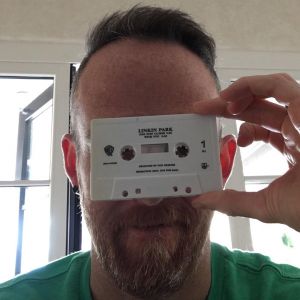
Several promotional items were released by the band before the album. Besides the Xero tape and the Hybrid Theory EP, the band did a two-track CD containing early versions of "A Place For My Head" and "By Myself" in 1999 which was distributed during their shows. A cassette tape containing the final versions of "With You" and "Points Of Authority" was available for free[148] on the merch table at the band's first shows as Linkin Park.[149][150] An EP entitled 3-Song E.P. was released in August 2000.[151] Another cassette, entitled Linkin Park Sampler, containing "One Step Closer" and "With You" was sent out to street team members via Streetwise and given away by radio stations, namely New York City's KROCK and San Francisco's Live 105, and at their shows[152] to promote the band's debut single. The band also had a few songs featured on samplers such as Ozzfest Sampler 2000, Bullshit Free,[153] and Raw Power.
The band's biography from hybridtheory.com, written in 2000, reveals the band had plans to release a five song EP and tour in the US West Coast in May,[38] but the EP never materialized. The potential content of the EP is unknown.
Mike Rittberg, who was vice president of promotions at Warner Bros. Records, is credited with conceptualizing a marketing plan key to propelling formerly unknown Linkin Park's debut record, Hybrid Theory, to $10M in global sales and multi-platinum status.[154]
Jeff Blue said, "In 2000, at a radio convention, programmers got an early taste of "One Step Closer" and began demanding to play the track. Warner Bros., in poetic synergy, rushed out the single to rock radio and moved up the release date for the album, now called Hybrid Theory, to October 2000. A few weeks later, Chester and I were vacationing in Mexico. A girl walked past Chester, saw his wrists adorned with fire tattoos, and said to her friend, "That's the guy in the video I told you about!" The "One Step Closer" video had been out only a couple of weeks, and that was all the confirmation I needed to know that Chester, along with the rest of the band, was on his way to stardom."[7] "One Step Closer" was followed in 2001 by the singles "Crawling", "Papercut" (in the UK) and "In The End".
Linkin Park toured in 2000 as a supporting act for The Union Underground, Kottonmouth Kings, P.O.D., and Papa Roach, embarking on headline tours in North America and Europe the following year. They also supported Deftones on their Back To School Tour and took part on Ozzfest and The Family Values Tour.
Brian Bennington, Chester's brother, ran a newsletter called Insider from mid-2000 to 2001, giving fans updates on the band's activities.[155]
Reception
Critical Reception
Mike Shinoda said:
"When we released Hybrid Theory. Our first album was painful to make, because it seemed like everyone was trying to tell us to change. They wanted us to be more like this band or that band, and we fought it tooth and nail the entire way.
So, that is to say: we made the album we wanted to make.
But once it came out, it took off surprisingly fast, and we got a lot of criticism for it entering the mainstream so quickly!
We had to overcome a lot of our own fears about what it meant to “sell out,” and realized that we never “sold out” at all—we did what we wanted to do, and people reacted to it in a positive way.
As long as we didn’t compromise our integrity, we could stand behind the record, which is what we did."[156]
Chart Performance
Awards
Gallery
-
Standard cover
-
Cassette tape
-
2002 Special Edition (2 CDs)
-
Filipino Special Edition with sticker
-
2013 vinyl
-
Record Store Day 2013 vinyl
-
Record Store Day 2013 vinyl with sticker
-
Hot Topic Clear vinyl
-
Walmart Red vinyl
-
Album Advance
-
CD-ROM Entrevista (interview)
-
Songbook
-
Hybrid Theory (Digital Video Compilation)
-
Hybrid Theory: Live Around The World digital album
-
Hybrid Theory: Live At Download Festival 2014 digital album
-
Hybrid Theory: Live At Download Festival 2014 with Parental Advisory label
-
Studio Collection 2000–2012 digital box set
-
Soldier without wings[158]
-
Hybrid Soldier concept with butterfly wings[159]
-
Hybrid Soldier concept with butterfly wings
-
Mista Hahn's Tasty Gas Station Breaks From The Orient vinyl (used live)
-
Projekt Revolution 2002 program
-
One Step Closer: From Xero to #1: Becoming Linkin Park
-
Poster
-
Poster
-
Poster
-
Poster
-
Hybrid Theory Skate Deck
-
Brown Hybrid Theory skate deck top
-
Black Hybrid Theory skate deck top
-
Red Hybrid Theory skate deck top
-
Hybrid Theory skate deck bottom
Trivia
- The oldest songs in the album are "Fogotten", "Runaway" and "A Place For My Head".[160][161]
- When Chester was auditioning for Linkin Park, another singer being auditioned took a microphone and said, "I'm just gonna say this right now. If you guys don't take this guy then you're fucking idiots." He handed back the microphone and went, "See you later."
- Hybrid Theory is mentioned in the Midnight Sun book from the Twilight saga.[162]
External Links
Music Videos
- "One Step Closer": LPTV | WBR | WMG | MTV
- "Crawling": LPTV | WMG | MTV
- "Papercut": LPTV | WMG | MTV
- "In The End": LPTV | WBR | WMG | MTV
- "Points Of Authority": MTV
Live Videos
- "Crawling" (Dragon Festival 2001): LPTV | WBR
- "Points Of Authority" (Texas 2003): WMG
- "Papercut" (Smokeout 2003): Fremont Studios
- "Points Of Authority" (Smokeout 2003): Fremont Studios
- "One Step Closer" (Clarkston 2007): Simply New YouTube | Simply New Vimeo | Marc Scarpa | NowWhat
- "One Step Closer" (Concert For The Philippines 2014): AXS TV Concerts
- "One Step Closer" (Vans Warped Tour 2014): VindicateMediaLLC
- "One Step Closer" (KROQ Red Bull Sound Space 2014): LPTV
- "Papercut" (Snippet) (Telekom Street Gigs 2012): WMG
LPU-TV
References
- ↑ 1.0 1.1 1.2 1.3 1.4 1.5 Blue, Jeff (2020). One Step Closer: From Xero to #1: Becoming Linkin Park. Permuted Press. ASIN: B08LMZLXTJ
- ↑ Entrevista a Kyle Christner (ex HT 1999) - Taringa!, February 21, 2011
- ↑ LPFan.com
- ↑ 4.0 4.1 Linkin Park | Rhythm, January 31, 2002
- ↑ Linkin Park Wants Out Of Warner Bros. Contract | Billboard, May 03, 2005
- ↑ 6.0 6.1 Linkin Park Steps Out - TIME, January 20, 2002
- ↑ 7.0 7.1 Chester Bennington: Former Warner Bros. A&R Jeff Blue Remembers Linkin Park's Early Struggles | Billboard, July 27, 2017
- ↑ Linkin Park’s 'Hybrid Theory' Turns 20 | SPIN, October 23, 2020
- ↑ Signings-04-00.pdf, April 2000
- ↑ 10.0 10.1 10.2 10.3 Interview: Linkin Park | Rolling Stone, March 14, 2002
- ↑ 11.0 11.1 Linkin Park | Pollstar, December 18, 2000
- ↑ Rob McDermott - It was October 1999 when some scrawny rock kid..., July 20, 2017
- ↑ Signings-09-00.pdf
- ↑ My Linkin Park "Decade List" « Mike Shinoda's Blog, January 02, 2010
- ↑ LPFan.com, November 28, 2000
- ↑ Interview with Linkin Park, September 2001
- ↑ Linkinpark.com Whois Lookup - Who.is - Who.is
- ↑ 18.0 18.1 Linkin Park - From A Whisper To A Scream - A Documentary Film - YouTube, March 06, 2014
- ↑ Guitar World Magazine Brad Delson Feature - Linkin Park Web
- ↑ Linkin Park: Everyone's Hometown Band - ABC News, April 12, 2001
- ↑ Metal-is.com Interview, Shut Up When Im Talking To You - Mike Shinoda Clan, January 2001
- ↑ Чат с Майком Шинодой. Обсуждение на LiveInternet - Российский Сервис Онлайн-Дневников, December 16, 2005
- ↑ Fort Minor – Get Me Gone Lyrics | Genius Lyrics
- ↑ Scuzz Meets Linkin Park - YouTube, July 18, 2014
- ↑ After Ten Years, Fort Minor Is Back, and Mike Shinoda Still Wants You to Remember the Name | NOISEY, June 23, 2015
- ↑ Linkin Park: The Ride | Episode Highlights | MTV UK
- ↑ DIGITAL CURRENCY INNOVATION IN MUSIC & ENTERTAINMENT, March 29, 2016
- ↑ Chester Bennington Will Die in Arizona | Phoenix New Times, October 30, 2015
- ↑ Linkin Park | Rare Interview | The Lost Tapes, September 26, 2019
- ↑ Old LP Band members | LP Association Forums, September 05, 2017
- ↑ Former Linkin Park bass player sits down... - Humans of Addiction | Facebook, March 04, 2019
- ↑ LPLive Wiki - Grey Daze Story, October 31, 2015
- ↑ 33.0 33.1 33.2 Hybrid Origins: A Look Back At The Early Days - Linkin Park Live, June 2021
- ↑ Linkin Park's Unknown Bass Player: Mike Elizondo - Newswire - Linkin Park Live, February 17, 2016
- ↑ Новости News, March 16, 2009
- ↑ Linkin Park- Metal Machine-Interview 2000 - YouTube, October 22, 2012
- ↑ 37.0 37.1 LinkinPark.ru - Всё о Linkin Park по-русски! | linkinparkru.com, May 11, 2008
- ↑ 38.0 38.1 New Page 1
- ↑ NRG Recording Studios (@nrgrecording) on Instagram: “#TBT Back when this little unknown band was working with Don Gilmore in Studio A. @linkinpark…”, November 05, 2015
- ↑ Metal-is.com Interview, Shut Up When Im Talking To You - Mike Shinoda Clan, January 2001
- ↑ Mike Shinoda, Linkin Park - Does Rock'n'Roll Kill Brain Cells? | NME.COM, November 25, 2010
- ↑ Stem 31 Interview 2000 - Mike Shinoda Clan
- ↑ A&R, Record Label / Company, Music Publishing, Artist Manager and Music Industry Directory, September 12, 2001
- ↑ LinkinPark.com [ bios ]
- ↑ Linkin Park's Mike Shinoda: "If you're expecting ESP guitars, then this album is not for you" - All Things Loud, April 11, 2017
- ↑ 46.0 46.1 46.2 Linkin Park's 'Hybrid Theory' Producer Calls Working With Chester Bennington a 'Dream Come True' | Billboard, July 24, 2017
- ↑ 47.0 47.1 47.2 Linkin Park Kerrang! | Tom Bryant - tom-bryant.com, January 23, 2008
- ↑ Linkin Park Central [prp interview], 2000
- ↑ Thank You Steve Jobs « Mike Shinoda's Blog, October 07, 2011
- ↑ Linkin Park: 'A Thousand Suns' - EMusician, November 29, 2017
- ↑ 51.0 51.1 51.2 Linkin Park Central [home]
- ↑ Linkin Park Central [CD now interview], 2000
- ↑ 53.0 53.1 Hi, I’m Jeff Blue! I am a multi-platinum producer, A&R, author, and songwriter. I have a passion for discovering and nurturing artists that will change the world! : Music, February 11, 2021
- ↑ 011.jpg
- ↑ liveDaily Interview: Linkin Park's Dave 'Phoenix' Farrell >> Tour dates and concert ticket info >> LiveDaily, February 04, 2004
- ↑ Linkin Park’s Compassionate Thrash – Rolling Stone, March 29, 2001
- ↑ 57.0 57.1 57.2 57.3 57.4 57.5 57.6 Shoutweb Interview 2000 - Mike Shinoda Clan
- ↑ Dot Music Interview - Mike Shinoda Clan, January 2001
- ↑ Yahoo Interview | Myblog's Blog, August 03, 2009
- ↑ Inside Linkin Park's Great Last Heavy Album: 'The Hunting Party' | Revolver, June 17, 2019
- ↑ Mike Q&A Summary 7/9/2020 - Newswire - Linkin Park Live, July 10, 2020
- ↑ We Reviewed Literally Whatever You Sent Us Volume 15 (with Mike Shinoda of Fort Minor) | NOISEY, June 24, 2015
- ↑ Phoenix of Linkin Park Loves The Bruery by Bruery Radio | Free Listening on SoundCloud, November 20, 2017
- ↑ LMNO – Die Jesus-Rapper kommen, October 20, 2006
- ↑ The Visionaries - Collab'ing with LP | SucksBBS.Net, October 15, 2006
- ↑ 66.0 66.1 "plaster" « Mike Shinoda's Blog, February 20, 2008
- ↑ Joe Hahn on Twitter: "@NinjaDelson the record label decides #HybridTheory20" / Twitter, October 15, 2021
- ↑ Joe Hahn on Twitter: "@rosario_lp_stan we have input but not up to us. not do we want to have the responsibility to choose. just write the best songs we can #HybridTheory20" / Twitter, October 15, 2021
- ↑ Wemix Contest Q&A #1: Zii « Mike Shinoda's Blog, December 14, 2008
- ↑ Young Band, Derailed Dream - NYTimes.com, October 01, 2002
- ↑ Jeff Blue (@jeffbluemusic) on Instagram: “People deal with struggle in many different ways. Please listen to your friends when they reach…”, July 20, 2017
- ↑ pushmeaway.com
- ↑ 73.0 73.1 Transcript: LPU Chat with Chester, August 02, 2011
- ↑ 010.jpg
- ↑ Xero on the tv show 'The Crow: Stairway to Heaven' - Everything Linkin Park - Linkin Park Live, August 25, 2011
- ↑ 76.0 76.1 76.2 Linkin Park : The Proven Theory >> Studio Reports
- ↑ Drawing stream today! Doing a bunch of fan requests, cartoons, and various doodles. - YouTube, June 04, 2020
- ↑ Chester Transcript 1 (LPU Chat), April 2003
- ↑ Chester In Kerrang! Magazine - Newswire - Linkin Park Live, November 04, 2010
- ↑ Yahoo! LAUNCH - Feature: Parkin' With Linkin Park, October 12, 2003
- ↑ New Page 2
- ↑ Mike LPU Chat 11/19/2011 Summary - Mike Shinoda Clan
- ↑ 83.0 83.1 Linkin Park to Finally Release Long-Awaited 'Pictureboard' Song, September 29, 2020
- ↑ Mike Q&A Summary April 15th, 2020 - Newswire - Linkin Park Live, April 15, 2020
- ↑ LPA Podcast w/ Mike Summary - Newswire - Linkin Park Live, December 08, 2015
- ↑ LPU 12 PERTH JAM 1 - XERO REBORN - YouTube, October 08, 2013
- ↑ New Xero Titles: "Dreamer" and "Weight" - Newswire - Linkin Park Live, December 08, 2020
- ↑ 10.20 Freestyle Session in Ableton Clips mode - YouTube, October 26, 2020
- ↑ Mike Q&A Summary 6/18/2020 - Newswire - Linkin Park Live, June 21, 2020
- ↑ Forfeit The Game Linkin Park Forums -> LPU Chat With Mike, August 19, 2006
- ↑ Bloggang.com : Circlegriff : A Place for Linkin Park Klan Thailand, June 17, 2008
- ↑ Mike Shinoda on Twitter: "I don't think so? Not sure why! #HybridTheory20" / Twitter, October 09, 2020
- ↑ Response to comments: "She Couldn't," etc. « Mike Shinoda's Blog, July 03, 2009
- ↑ Twitch: Mike Shinoda - 8.13 Animal Crossing Stream - visiting fan islands. Also, talking about #HybridTheory20 at the top of the stream., August 13, 2020
- ↑ Facebook: Mike Shinoda - "She Couldn't", August 14, 2020
- ↑ Linkin Park recall ‘crying for joy’ hearing Chester Bennington’s voice for the first time | Louder, September 29, 2020
- ↑ Mike Rittberg on Twitter: "@mikeshinoda @linkinpark look what I found.... https://t.co/Bb7n7gO0OW" ., September 29, 2016
- ↑ Linkin Park Online - Press - September 29th, 2000 Live Review.
- ↑ Chester Bennington Opens Up About His Past Addictions, July 16, 2009
- ↑ Linkin Park Interview #2 ~ 2000-11-25 on Much (USA) - YouTube, August 22, 2008
- ↑ 101.0 101.1 MSN Music Interviews Mike Shinoda – Linkin Park: ‘Living’ Proof - Mike Shinoda Clan, June 27 2012
- ↑ Twitch: Mike Shinoda - 8.24 / I'm back!, August 24, 2020
- ↑ 103.0 103.1 linkinpark.com chat 010710, July 10, 2001
- ↑ Linkin Park discuss making of debut album 'Hybrid Theory' to mark its 15th anniversary - listen, October 26, 2015
- ↑ New Page 2
- ↑ 106.0 106.1 106.2 Linkin Park Web Interview - Mike Shinoda Clan, September 14, 2000
- ↑ LPCatalog - 2001 Hybrid Theory Misc / Promo / Points Of Authority, United Kingdom, CD-R, March 31, 2012
- ↑ Linkin Park Q&A | [V Music], August 12, 2012
- ↑ LinkinPark.ru - Всё о Linkin Park по-русски! | linkinparkru.com, May 12, 2008
- ↑ 110.0 110.1 Jan.11_2002chat, January 11, 2002
- ↑ Rock Extreme Interview - Mike Shinoda Clan, 2001
- ↑ Digging Deep – A Conversation With Chester About Songwriting – Kevin Palmer, November 10, 2017
- ↑ Bucket Of Weenies - Club Tattoo 11th Anniversary 2006-04-22 - YouTube, January 02, 2014
- ↑ Linkin Park's Mike Shinoda on EDM, "A Light That Never Comes," and Their New Remix Album | Complex, September 26, 2013
- ↑ Chester Transcript 3 (LPU Chat), January 2002
- ↑ 116.0 116.1 HOB.com: Linkin Park Text Interview recorded 11/30/2000, November 30, 2000
- ↑ Linkin Park Dig Up Dust Brothers Track - MTV, January 30, 2001
- ↑ LPFan.com, January 26, 2001
- ↑ Linkin Park - Live from Wantagh, New York 2007 (Full Show) - YouTube, September 08, 2017
- ↑ Dynamic Rock's Interview - Linkin Park Web
- ↑ Joe Hahn Quotes
- ↑ Articles/interviews
- ↑ 123.0 123.1 The PRP - The World's Largest Selection Of Mallcore, Complete With Food Court, December 09, 2000
- ↑ Joe, Brad and Rob (MSN Chat), 2001
- ↑ linkinpark.com chat 010710, July 10, 2001
- ↑ LINKIN PARK ARCHIVE — Frank Maddocks Design
- ↑ Frank Maddocks on Instagram: #tbt my 2nd album cover I designed @wbr with @m_shinoda and @linkinpark 14 years ago... I'm gettin' old! #albumart #stencil #art..., July 10, 2014
- ↑ 128.0 128.1 Podcast w/ LP Art Collaborator Frank Maddocks - Newswire - Linkin Park Live, June 06, 2019
- ↑ ART OF METEORA PART 1 - YouTube, July 25, 2006
- ↑ Frank Maddocks on Instagram: “18 years ago today @linkinpark #hybridtheory was released! | After numerous creative conversations with the band about the idea of merging…”, October 24, 2018
- ↑ Monday! What should we do or make today? Come say hi. - YouTube, April 20, 2020
- ↑ LPLive: Mike Q&A Summary 6/26/2020, June 26, 2020
- ↑ LPLive: Mike Q&A Summary 1/11/2021, January 11, 2021
- ↑ Warner Re-Release Hybrid Theory Vinyl? - Everything Linkin Park - Linkin Park Live, February 18, 2013
- ↑ Hybrid Theory CLEAR Vinyl - Everything Linkin Park - Linkin Park Live, November 05, 2013
- ↑ LINKIN PARK on Twitter: "Check out the exclusive colored vinyl of “Hybrid Theory” and “Minutes To Midnight” at @Walmart Hybrid Theory: https://t.co/JSASdy7LOC Minutes To Midnight: https://t.co/N30q6hlawi https://t.co/lqeMpIvZme" / Twitter, November 21, 2021
- ↑ Linkin Park Catalog, Exclusive Bonus Tracks & Digital Booklets Now Available on the iTunes Music Store - Apple, August 29, 2006
- ↑ Linkin Park - Download Linkin Park Music on iTunes
- ↑ Linkin Park: Live Around The World - Newswire - Linkin Park Live, May 30, 2012
- ↑ Hybrid Theory | HDtracks - The World's Greatest-Sounding Music Downloads
- ↑ Linkin Park "Studio Collection" / Deluxe Editions - Newswire - Linkin Park Live, January 13, 2013
- ↑ Amazon Music Partners with Universal Music Group and Warner Music Group to Exclusively Remaster and Deliver Thousands of Songs and Albums at the Highest Quality Streaming Audio Available, October 2, 2020
- ↑ Apple Music announces Spatial Audio and Lossless Audio - Apple, May 17, 2021
- ↑ News / Updates - Linkin Park Web, 2000
- ↑ Interview With David "Beno" Benveniste | LA Music Blog, March 14th, 2011
- ↑ StreetWise FAQ's
- ↑ Dave Phoenix Farrell on Instagram: “Found this today... Promo cassette that @wbr did before #hybridtheory ... Can't believe this thing is 16 years old. Anyone have a cassette…”, May 08, 2016
- ↑ Linkin Park’s Mike Shinoda On Dealing With Brutal Criticism & Fighting Tooth And Nail For Your Vision | Turnaround Magazine, April 2014
- ↑ UnEathed.com's Concert Review / Band Of The Month Feature - Linkin Park Web
- ↑ UnEarthed.Com : Reviews : Half Cocked, Linkin Park, Prizefighter, and Famous at the Whisky 7.8.00
- ↑ Stem 31's Band Of The Month Feature - Linkin Park Web
- ↑ Brandon Fuston - My heart is hurting right now!! R.I.P CHESTER!!..., July 20, 2017
- ↑ Linkin Park Guestbook, October 11, 2000
- ↑ Mike Rittberg | Professional Profile
- ↑ pushmeaway.com
- ↑ Linkin Park’s Mike Shinoda On Dealing With Brutal Criticism & Fighting Tooth And Nail For Your Vision | SUBvert Magazine, November 2009
- ↑ Frank Maddocks on Instagram: “Congrats to @linkinpark on the 20th Anniversary of Hybrid Theory. I’m honored to have contributed to the album and grateful for the…”, October 10, 2020
- ↑ Frank Maddocks on Instagram: “Congrats to @linkinpark on the 20th Anniversary of Hybrid Theory. I’m honored to have contributed to the album and grateful for the…”, October 10, 2020
- ↑ Frank Maddocks on Instagram: “Congrats to @linkinpark on the 20th Anniversary of Hybrid Theory. I’m honored to have contributed to the album and grateful for the…”, October 10, 2020
- ↑ Mike Shinoda on Twitter: "Oldest songs on #HybridTheory - Forgotten, APFMH, and Runaway (I THINK in that order)" / Twitter, October 09, 2020
- ↑ Mike Shinoda on Twitter: "AKA Rhinestone, Esaul, and Stick N Move #HybridTheory20" / Twitter, October 09, 2020
- ↑ Did You Know That Linkin Park’s ‘Hybrid Theory’ Is Mentioned In The New Twilight Book? - News - Rock Sound Magazine, September 07, 2020
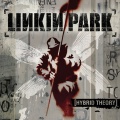

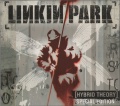

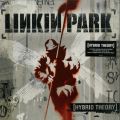
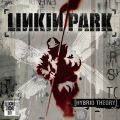
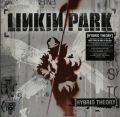
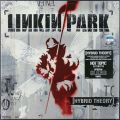
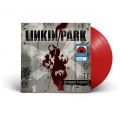
![20th Anniversary Edition[157]](/w/images/thumb/1/1d/Hybrid_Theory_20th_Anniversary_Edition_cover.jpg/120px-Hybrid_Theory_20th_Anniversary_Edition_cover.jpg)
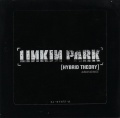
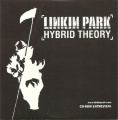

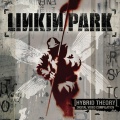
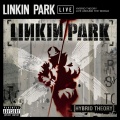

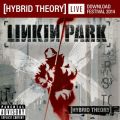

![Soldier without wings[158]](/w/images/thumb/6/6f/HT20_Soldier.jpg/120px-HT20_Soldier.jpg)
![Hybrid Soldier concept with butterfly wings[159]](/w/images/thumb/8/86/Hybrid_Soldier_Concept.jpg/120px-Hybrid_Soldier_Concept.jpg)

